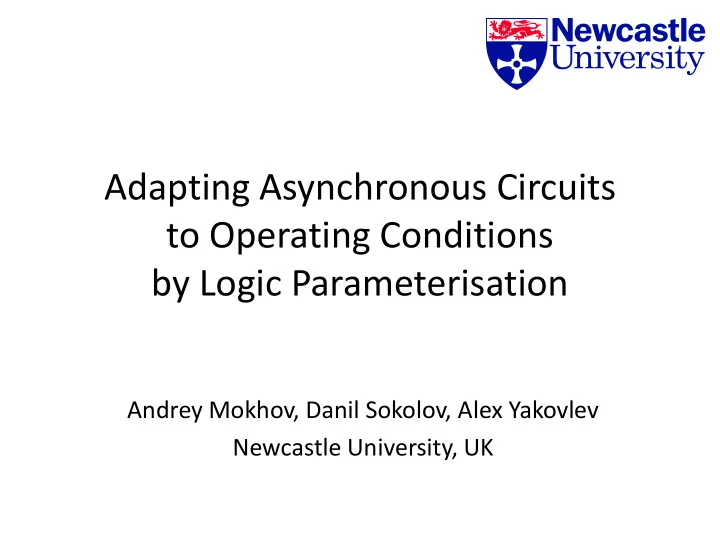

Adapting Asynchronous Circuits to Operating Conditions by Logic Parameterisation Andrey Mokhov, Danil Sokolov, Alex Yakovlev Newcastle University, UK
Designer’s dilemma • Contradicting requirements: o ↑ performance, ↓ energy consumption, ↑ robustness o high performance → high energy consumption o low energy consumption → low robustness o high robustness → low performance • Competing implementation styles: – Synchronous – Asynchronous • Delay Insensitive (DI) • Speed Independent (SI) or Quasi Delay Insensitive (QDI) • Bundled data, relative timing assumptions (TA) • ...
Energy-efficiency v Robustness
Parameterised Circuits • Static parameters set at test/binning stages • Dynamic parameters: – Power management controller – Maintenance mechanisms
Parameterised Circuits: Trivial Approach • Easy to design! • Large overheads • How can we do better?
Parameterised Circuits: Better Approach • Goal: – Combine circuit implementations efficiently • Key observations: – Externally: the circuits have the same interface – Internally: the circuits behave similarly • Solution: use a model that can capture functional similarities at the circuit level – Conditional Partial Order Graphs almost fit
Conditional Partial Order Graphs x=0 x=0 y=0 y=1 x=1 x=1 y=1 y=0
Conditional Partial Order Graphs Describe concurrency and causality Capture similarities in behaviours Represent families of partial orders • acyclic • not directly applicable to circuit specification Is it possible to specify cyclic behaviour using acyclic objects? – Yes!
Describing cycles
Describing cycles
Describing cycles
Describing cycles
Describing cycles x = x = 0 1
Describing cycles set x = 0 set x = 1 x + x – Initial state: x = 1
Describing cycles x = 1
Describing cycles x = 0
Describing cycles x = 1
Describing circuits: oscillator x = 0 STG x = 0 Conditional Signal Graphs (CSGs)
Describing circuits: C-element STG
Describing circuits: C-element CSG
Describing circuits: C-element
Describing circuits: C-element
Describing circuits: C-element
Describing circuits: C-element
Describing circuits: C-element
Describing circuits: C-element
Describing circuits: C-element
Describing circuits: C-element
Circuit composition C-element AND-gate C/AND-element
Circuit composition C-element: AND-gate: C/AND-element: ↑ max(a↑, b↑) can be chosen ↑ max(a↑, b↑) ↓ max(a↓, b↓) in run-time! ↓ min (a↓, b↓)
Circuit composition • Algebraic operations with CSGs: – Addition (overlay): G 1 + G 2 – Scalar multiplication (encoding): f G • Composition of C-element and AND-gate: • General composition of n circuits: • Fast structural operation (if encoding is given)
Design flow • Heterogeneous models and implementation styles • Not computationally expensive: – composition is fast – exact encoding is slow but there are fast approximate methods
Example: Read/Write controller
Example: possible implementations Delay Insensitive (DI) Partial Acknowledgement (PA) T = d + max{d 1 , d 2 , d 3 } + C 3 T = d + max{d 1 , d 2 } + C 2 Timing Assumptions (TA) Synchronous (CL) T = d + I T = t clock
Example: parameterised controller Can be switched off by power-gating in TA/CL modes
Example: simulation results
Cost of Parameterisation • Trivial approach: – Latency overhead: 120-182%, 122% on average – Energy overhead: 151-330%, 201% on average • Our approach: – Latency overhead: 0-40%, 19% on average – Energy overhead: 0-98%, 23% on average • Latency/energy savings at the system level!
Conclusions & Future work • “Don’t oppose different implementation styles, take advantage of their benefits!” (reviewer X) • New model for circuit-level description and composition • Cost of parameterisation is not prohibitive • Future work: – Tool prototyping – CSC signals awareness – Power-gating mechanisms
Questions?
Recommend
More recommend